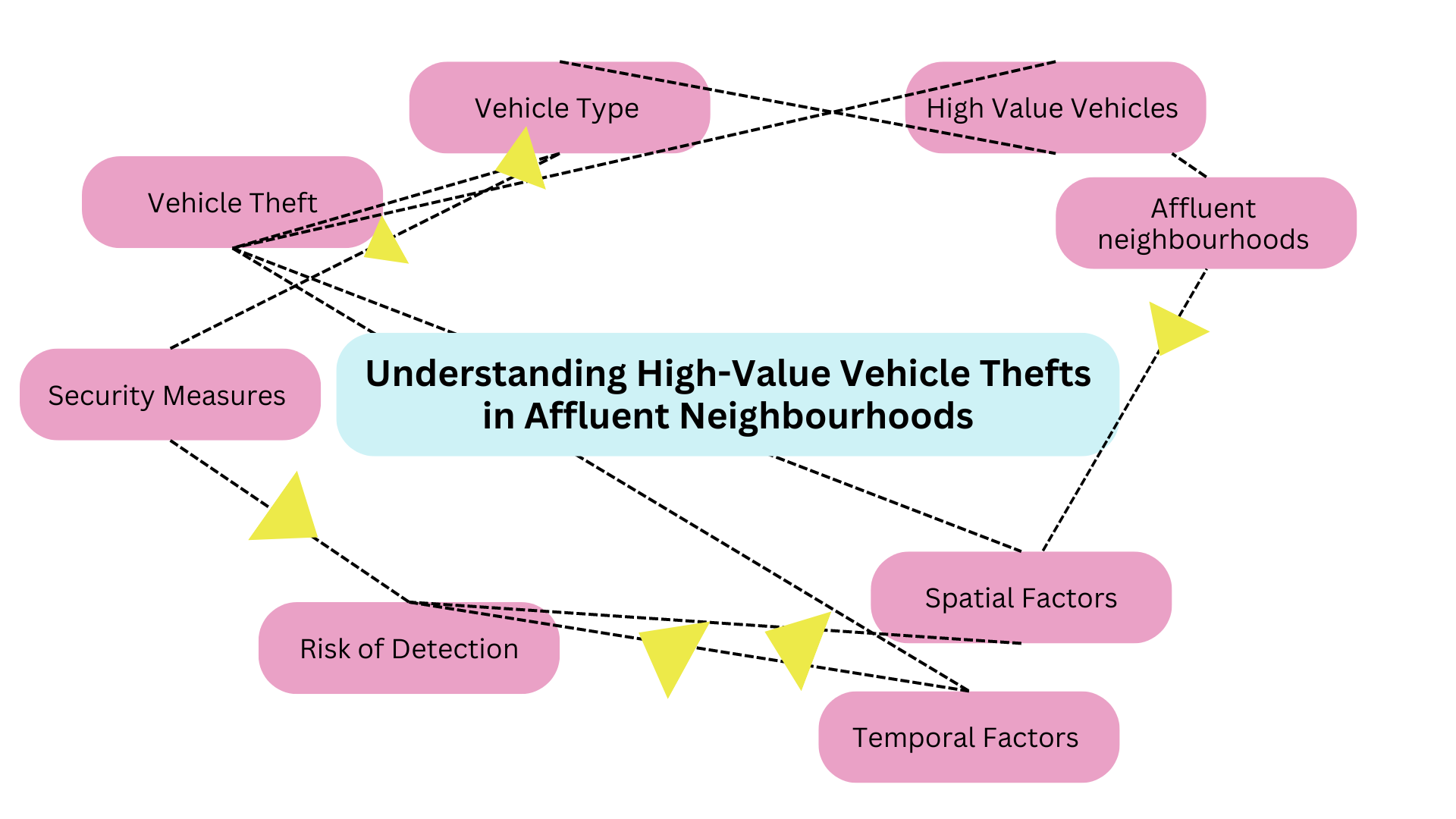Conceptual vs theoretical framework
Conceptual vs theoretical framework. What’s a conceptual framework? What’s a theoretical framework? What’s the difference between them? How are they connected?
Keep reading, because I’m going to explain that and we’re going to work through an example study, because this stuff can be a bit abstract!
If we’ve not met before - hi, I’m Dr Elizabeth Yardley and I’ve been working in UK universities for the last 20 years, supporting social sciences graduate students through their dissertations. Conceptual and theoretical frameworks are very commonly confused – by students and academics alike - so I thought it was high time I wrote a blogpost about them so, let’s get straight into it.
(1) The basics - defining conceptual and theoretical frameworks
What’s a conceptual framework?
A conceptual framework is a structure that organises and guides the research process by defining key concepts, variables, and relationships. It helps you conceptualise your study, and by that I mean form an idea in your mind of your study, of what it’s looking at. It’s essentially a map for organising ideas. So it helps you get clear on exactly what you’re exploring in your research, what things you’re examining and how those things relate to each other.
What’s a theoretical framework?
A theoretical framework on the other hand is as a set of established theories or perspectives that inform your approach to the research and guide your data analysis and interpretation. So, you won’t just grab your conceptual framework and go, you need to see what’s been done before by other researchers. What theories exist in this area? What ways of making sense of things are out there already that might be helpful to you? Theoretical frameworks provide a structure within which you can interpret your findings and make your contribution to knowledge.
So, to summarise: Conceptual frameworks focus on defining key concepts and relationships within your study. Theoretical frameworks draw upon established theories to guide the research process and interpret findings within a broader context.
Now, before we go any further, I think we need an example, don’t we?
Here’s our example topic, which would fall within the subject area of criminology: “Understanding High-Value Vehicle Thefts in Affluent Neighbourhoods”.
(2) Conceptual framework for the example study
First up, let’s have a think about an initial conceptual framework – and I say initial because it’s provisional. We will probably revisit it to tweak and change things in future, but for now, we want something to get started with
The obvious thing to do first is to take your research title and highlight the nouns, the words representing people, places or things.
So, in the example, we’ll have:
High value vehicles. These are the primary objects of interest in our study, representing valuable assets that are targeted by thieves.
Vehicle thefts. The actual taking of the vehicles, when someone comes and nicks a nice Range Rover or whatever. That will involve looking at the patterns in vehicle thefts – is there a regularity to this, what do these vehicle thefts look like?
Affluent neighbourhoods. What is an affluent neighbourhood? How are you deciding that? Is it property prices, home ownership?
So, high value vehicles, the theft of high value vehicles, affluent neighbourhoods – all central ideas, yes?
Now, if this was your topic, you might do a bit of brainstorming and have a think about other concepts that might be relevant that are linked to those you have already identified. For example:
Security measures. Examining the effectiveness of security measures such as alarms, steering wheel locks, and surveillance cameras in deterring thefts and protecting vehicles.
Risk of detection. The perceived risk of detection by thieves and its influence on their behavior and targeting preferences.
Types of vehicles targeted. Identifying specific makes, models, or features of vehicles that are more vulnerable to thefts.
Temporal factors. Aspects such as the time of day when thefts are more likely to occur and how temporal patterns may vary across different contexts.
Spatial factors. Such as the location of houses and vehicles within neighbourhoods, proximity to main roads or highways, and neighborhood layout.
By incorporating these additional factors into our conceptual framework, we can develop a more comprehensive map of all the important things about high-value vehicle thefts in affluent neighbourhoods. This framework will guide our data collection, analysis, and interpretation as we seek to address the research questions outlined in our study.
This diagram below provides a visual overview of the conceptual framework, illustrating the central concepts and some of their interconnections. You can adapt and customise a diagram like this based on your specific research focus and the relationships you want to emphasise. Remember - it’s provisional! So, it’s likely to be messy (like mine in the example), but started is way better than perfect!
(3) Theoretical framework for the example study
Now that we've outlined the basic framework for our example study, let's explore the theories that help us understand why these crimes happen – which will help us develop a theoretical framework.
The conceptual framework gave us a way to organise the main ideas we're looking at. But now, we want to dig deeper into existing ideas that will help explain what's going on.
Before, we talked about the main things we're studying, like the types of cars stolen and where it happens. Now, we're going to look at theories that help us make sense of all these things. So, what you would do here is you would dive into the academic literature around making sense of crime in general and property and vehicle crime in particular, and you’d see what theories exist around this.
You’d judge those theories. You’d evaluate them. You’d figure out how helpful or not they might be to your study.
Some of the theories you might come across might include things like:
Routine Activity Theory, which says that crime is the coming together of a motivated offender, a suitable target, and the lack of a capable guardian.
Left Realism, which includes the square of crime – exploring relationships between state, public, victim and offender.
Cultural Criminology, which includes an examination of the emotions and meanings associated with crime and crime control - for example the work of Jack Jatz in his book, “Seductions of Crime”.
Psychosocial Criminology, which examines individual motivation via psychoanalytic concepts and the notion of hidden, unconscious drivers of crime rooted in individual biographies.
All those theories are quite different. There are some overlaps, but some of them are focused on the individual, others are focused on the overarching structure of society. How do you know which ones you should go for?
Well, you need to think about your own research paradigm. Where are you coming at this topic from? What assumptions do you hold about this topic? What is your broader philosophical stance?
Your paradigm is like the set of glasses you use to look at the world. How the world appears to you will differ depending on where you are located paradigm-wise. This might draw you towards particular factors within your conceptual framework and particular theories you’ve encountered during your review of the literature.
For example, are you a positivist, who’s all about finding patterns and rules in an attempt to explain things and identify the causes? You focus on what you can see and measure, like behaviors and numbers, to generate knowledge of how things work. Your theoretical framework, in relation to understanding high value vehicle thefts in affluent areas might lean heavily upon routine activity theory. You might look closely at those three component parts of crime: motivated offender, a suitable target, and the lack of a capable guardian. You might want to explore which of those factors plays the biggest role in vehicle crime.
Or are you an interpretivist, who’s more interested in people's stories and experiences? Your focus is on understanding things and identifying the meanings, getting to know how individuals make sense of their world. For you, context and social interactions are key to understanding why people’s feelings and actions. You might lean more towards a theoretical framework that encompasses cultural criminology and psychosocial criminology. These frameworks will help you explore the experiences of those involved, car thieves, victims, potential victims.
Are you a critical realist, who acknowledges the merits of both? You recognise that there is an objective reality that exists ‘out there’, but you also value the importance of individual lived experiences within this structure. You understand things are complex, and there's more than one way to look at them. You're interested in uncovering the deeper structures and mechanisms that shape our world, balancing both objective realities and subjective interpretations. You might draw on left realism and some of the cultural criminological ideas in exploring high value vehicle thefts.
Back to conceptual and theoretical frameworks
What you might want to do once you’ve identified the important theories from the literature is add those theories to your conceptual framework diagram to bring the two together.
Just making a few notes about particular concepts, specific relationships, where theory may be helpful here. This might help you identify where gaps are – where there isn’t really much of a theory or an explanation, that your research can help plug that gap. Here’s an example of a couple of notes a positivist researcher might make on the conceptual framework I showed you earlier.
This is really good if you’re a visual person when it comes to your learning! To have it represented diagrammatically like this can be helpful as you’re going into your actual study. The diagram might not be set in stone - it likely won’t be - you’ll swap and change things as you learn more about the topic through your own study, but, it’s a start, right?
What next?
I hope you feel a bit more confident about conceptual and theoretical frameworks now. See? They’re not as difficult as you thought, right?!
If you like the way I explain things and you want me to help you out with some other theoretical, conceptual and paradigm-related stuff, check out my other blogposts on these topics. Grab a notebook and some snacks and click here to have a Netflix-style binge on them, start with this one!


